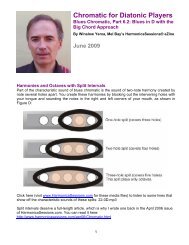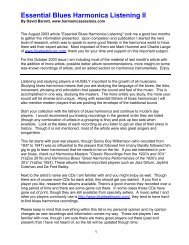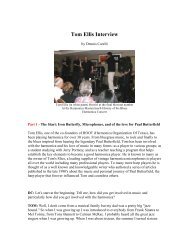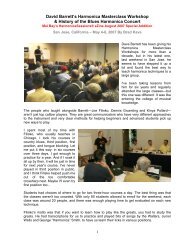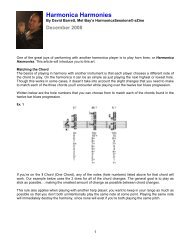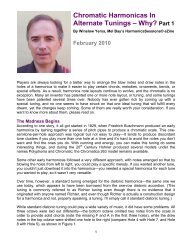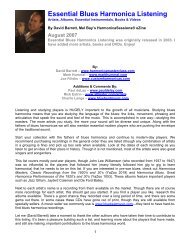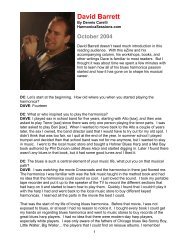Print this Article - Mel Bay's Harmonica Sessions
Print this Article - Mel Bay's Harmonica Sessions
Print this Article - Mel Bay's Harmonica Sessions
Create successful ePaper yourself
Turn your PDF publications into a flip-book with our unique Google optimized e-Paper software.
What to do with Hole #1?<br />
By David Barrett, <strong>Mel</strong> Bay’s <strong>Harmonica</strong><strong>Sessions</strong>® eZine<br />
October 2008<br />
Now that tongue blocking and puckering are both commonplace in the harmonica world (actually, they<br />
always have been, but more players are aware of tongue blocking now), there’s confusion as to what to<br />
do when playing the first hole on the harmonica. In <strong>this</strong> issue we’ll talk about <strong>this</strong> a bit.<br />
If you pucker all of the time (playing a single note by pursing your lips), then <strong>this</strong> isn’t really an issue for<br />
you. With that said… the more you study classic blues the more you’ll find yourself tongue blocking and<br />
<strong>this</strong> will become an issue. So, with the groundwork laid, let’s get rolling.<br />
Let’s say you’re tongue blocking on the lower end of the harmonica. The lick is 4, 3, 2 and 1 draw. You<br />
tongue block the 4, 3 and 2 draw, but what do you do with the 1 draw?<br />
Option 1 – Keep the Tongue On<br />
When tongue blocking, your tongue is aimed to the left, blocking the holes to the left and leaving the<br />
rightmost note in your embouchure to sound. For example: when playing the 4 draw in a tongue block,<br />
your lips are over four holes, with the tongue blocking holes 1 through 3, leaving the 4 draw to sound.<br />
When playing the 4 3 2 1 lick, you keep your tongue on the harmonica.<br />
The Advantages:<br />
Your tongue stays on the harmonica (no change).<br />
The Disadvantages:<br />
You have to decrease the size of your embouchure to fit your mouth over <strong>this</strong> area of the harmonica (we<br />
only have comb here, no cover plates). Since the embouchure is small, the tongue fills up a decent<br />
amount of your mouth cavity, possibly causing a thinner tone.<br />
Option 2 – Pucker<br />
When playing the 1 draw there’s nothing to block, so why not take your tongue off and pucker? This is<br />
the option most people take (I generally do <strong>this</strong>).<br />
The Advantages:<br />
You just lift your tongue off of the harmonica. Since the tongue is not on the face of the harmonica (the<br />
wood in <strong>this</strong> case), the mouth cavity is free from the tongue and could make a fuller tone.<br />
The Disadvantages:<br />
Your tongue leaves the face of the harmonica, which is essentially embouchure switching… an act of<br />
less efficiency. It can make fast runs, like 4 3 2 1, difficult to play smoothly.<br />
1
Option 3 – Side-Switch<br />
For <strong>this</strong> your tongue moves to the right side of your mouth, blocking the holes to the right and sounding<br />
the hole on the left, in <strong>this</strong> case the 1 draw.<br />
The Advantages:<br />
This is considered to have the best tone of all of the embouchures for two reasons.<br />
1) The embouchure covers more surface area of the harmonica, allowing for a larger<br />
embouchure for a deeper tone.<br />
2) With the lips covering more surface of the harmonica you’re able to smother the face of the<br />
harmonica more when playing amplified… a small detail, but an important detail if you’re<br />
looking for a big sound.<br />
When playing with pulls (a common rhythmic tongue block technique used in classic blues), the tongue<br />
just lifts off of the face of the harmonica to sound the chord… a very efficient way to play.<br />
The Disadvantages:<br />
Like switching to pucker, it can make fast runs like 4 3 2 1 difficult to play smoothly.<br />
Final Thoughts<br />
It’s fairly clear to me, and other educators I respect, that the classic players of the 1950’s tongue blocked<br />
pretty much all of the time and tongue switched for hole 1.<br />
With that said, you can get the same general results from any of these three options, you just need to<br />
experiment and try for yourself what YOU think feels, and most importantly SOUNDS, the best.<br />
Exercises<br />
Example 1<br />
Try <strong>this</strong> classic turnaround lick with each of the three ways of playing the first hole.<br />
Example 2<br />
Here’s a tongue blocking exercise to get you used to tongue switching.<br />
About the Author David Barrett<br />
http://www.harmonicamasterclass.com/david.htm<br />
2



